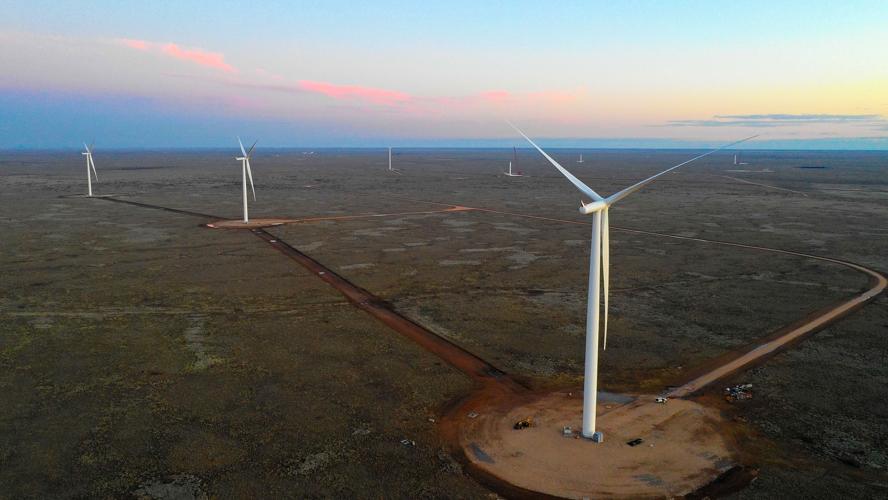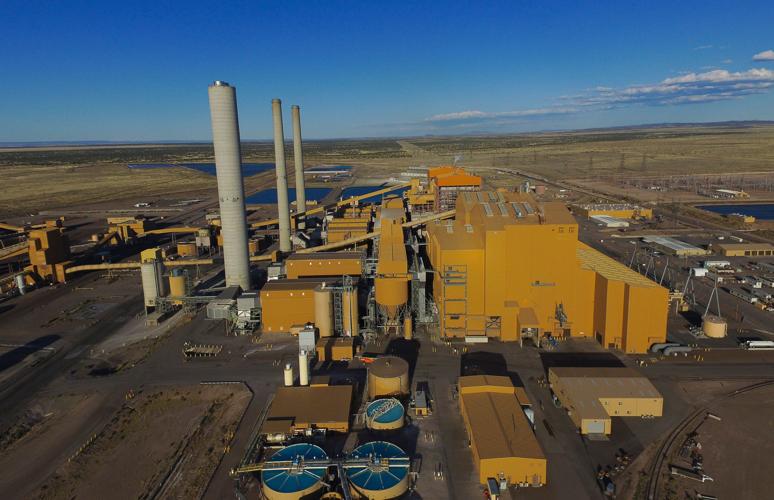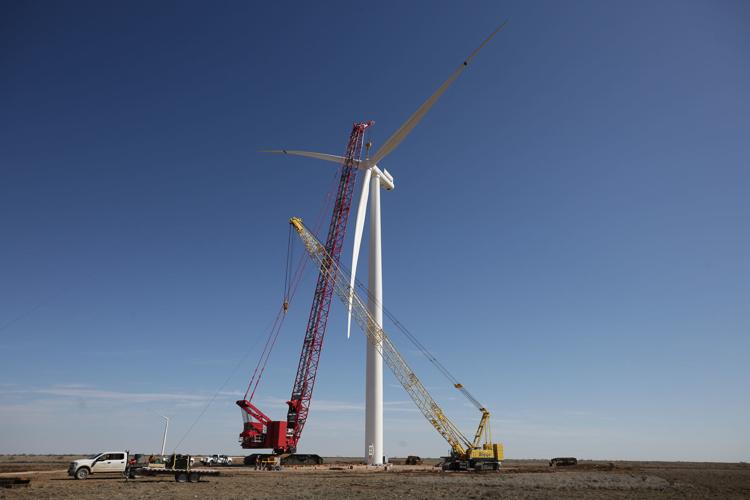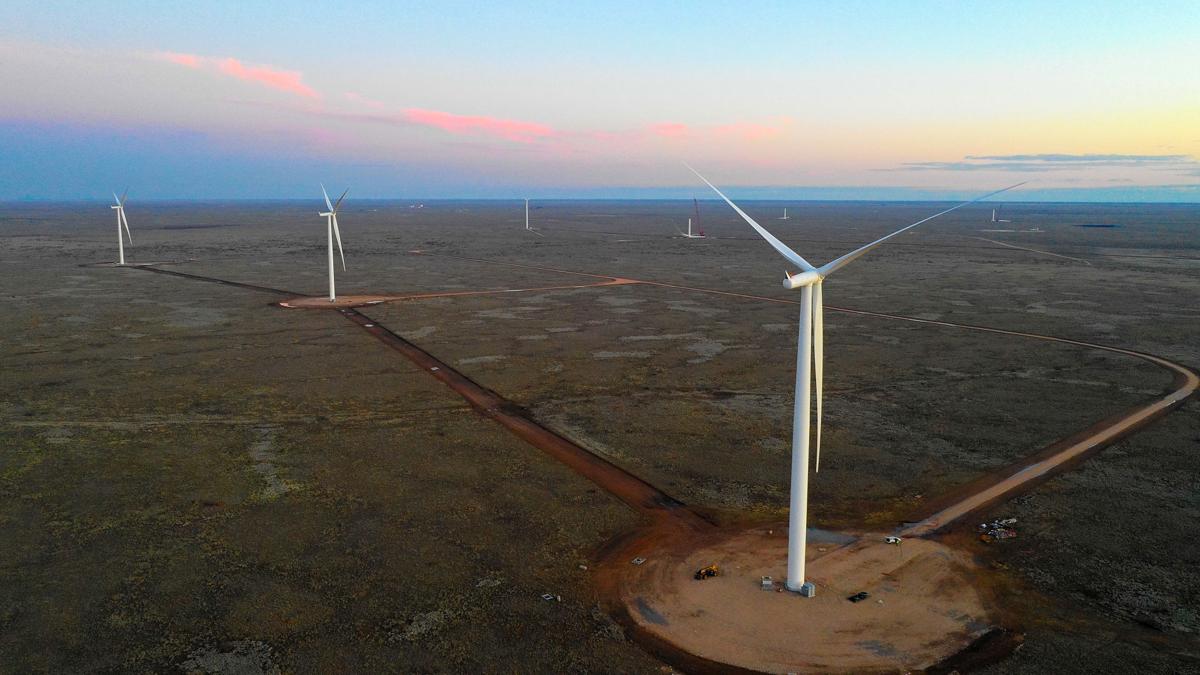In a dramatic policy shift, Tucson Electric Power says it will stop using coal to generate electricity by 2032 and will increase renewable energy’s share of its energy load to more than 70% by 2035.
As part of that change, the utility will stop buying electricity from its two units at its coal-fired Springerville Generating Station by 2032. The plant, TEP’s biggest power source, provides about 35% of its energy.
The utility already had planned to start up two New Mexico wind farms and a solar storage plant in the Tucson area by next year. The new plan calls for adding another 2,000 megawatts of renewable energy capacity by 2035.
The utility’s switch from fossil fuels is spelled out in the new plan, submitted to the Arizona Corporation Commission. Called an Integrated Resource Plan, it would reduce TEP’s carbon dioxide emissions 80% by 2035, compared to 2005 levels.
The plan drew generally positive reviews from a number of environmentalists and other representatives to an advisory committee that had worked with the utility for a year to prepare it.
Two commissioners, Chairman Bob Burns and Tucsonan Lea Marquez Peterson, also generally praised the plan although they held off on final judgment.
University of Arizona researchers said the plan would likely meet the utility’s share of the worldwide goal of holding down global temperatures to less than 2 degrees Celsius or about 3.6 degrees Fahrenheit above pre-industrial levels.
Springerville officials weren’t happy about it.
Also, a representative of the American Association of Retirees and the Pima Council on Aging expressed concern because the plan would require 1% annual electric rate increases a year to put into effect.
Sierra Club official Sandy Bahr said the plan, while a step in the right direction, doesn’t move fast enough to get TEP off coal. She listed 14 separate units of various Western coal-fired plants that are scheduled to shut down sooner than 2032, many in the 2020s.
But TEP says the plan best balances costs and environmental benefits compared to 24 other proposals it reviewed.
“We know our customers want safe, reliable energy from resources that are both affordable and environmentally responsible. TEP’s 2020 Integrated Resource Plan will help us maintain that delicate balance,” TEP CEO David Hutchens wrote in the forward to the plan.
The plan isn’t legally binding but is aimed at sending a signal to regulators and the public about TEP’s future direction. TEP and other regulated Arizona utilities update such plans every three years.
TEP has been one of the West’s more fossil fuel-friendly utilities. It stuck with coal even as many other utilities were moving away from it, and as the Sierra Club called on utilities to move beyond what it termed a highly polluting energy source that emits large quantities of heat-trapping greenhouse gases linked by scientists to global warming.
The Springerville plant emitted the second most greenhouse gases of any Arizona industrial plant in 2018, the most recent data available, Environmental Protection Agency records show. The biggest greenhouse gas emitter that year was the since-closed Navajo Generating Station in Page.
Last year, TEP got 13% of its electricity from renewables such as wind farms and solar plants along with photovoltaic solar panels atop individual homes. Fossil fuels coal and natural gas supplied the rest, a University of Arizona study paid for by TEP found.
TEP’s most recent prior resource plan, from 2017, called for boosting renewable use to 30% by 2030 and to cut coal to 38% of its electric load by then from 69% in 2017.
A TEP official said last week the utility is heading in a different direction not only due to concerns about greenhouse gas emissions but because of changing economics.
“For the last several decades, coal was the most economical resource. It was the lowest cost resource to supply energy for our customers, and it wasn’t really close,” said Jeff Yockey, TEP’s resource planning director.
But over the past few years, first natural gas prices and more recently solar and wind energy prices have fallen dramatically, he said. Their prices are projected to keep falling, along with battery-fueled storage of solar energy for use when the sun is down, he said.
“Coal just isn’t the most economical resource” now, Yockey said.
Yet the utility still needs, for now, the extra energy capacity that coal provides, he said.
“Being a utility with no nuclear or hydro(electric) energy, with coal, there is reliability, a fuel on the ground, 30 or 90 days supply,” he said. “It’s the only source not subject to disruption in the next hour. It’s our only long-term, stable fuel supply.
“Over time, we will be able to overcome that,” he said.

Tucson Electric Power will stop buying electricity from its two units at its coal-fired Springerville Generating Station by 2032. The plant is TEP’s biggest power source.
Totally different approach to creating plan
TEP’s path toward producing this plan was totally different from past plans.
The utility paid the University of Arizona $100,000 to have three UA researchers prepare two reports, one comparing 24 different proposals, a second comparing TEP’s fossil fuel/renewable split with those of other utilities.
Second, the utility appointed an advisory council representing environmental, business and government interests that met regularly to guide TEP in producing the plan. The utility chose a preferred energy “portfolio,” as the plan is called, that differed from earlier ones but reflected several, Yockey said.
The goal “was very much about basically achieving significant emissions reductions as quickly as we can and as cost effectively as we can,” he said. TEP wanted the biggest cumulative emission cut possible over 15 years.
“If it was just about cost, we wouldn’t have selected the portfolio that we selected. It wasn’t the lowest cost portfiolio.”
UA assistant research professors Ben McMahan and Will Holmgren said combined CO2 emission reductions from TEP’s new plan over 15 years would be expected to hit the Paris accord’s 2-degree target.
To determine that, the researchers first figured out how many cumulative emissions a hypothetical plan would produce if it lowered emissions the same amount every year and reduced emissions 90 percent total by 2050, they said. All TEP proposals analyzed had fewer cumulative emissions than that one, and the utility’s choice had still lower emissions, they said.
“There is considerable uncertainty about what will happen between now and 2050, but the preferred portfolio’s early start on reductions and lowest cumulative emissions is certainly a positive sign that well below 2C is achievable,” the researchers said in an email.
Enviromentalists pleased but some want more renewables faster
The Sierra Club, Western Resource Advocates, the Southwest Energy Efficiency Project and Pima County offered varying degrees of praise for the new TEP plan.
In a memo Friday, County Administrator Chuck Huckelberry said he’ll write the Corporation Commission congratulating TEP for “the comprehensive, inclusive and transparent process” used to develop the plan.
Because of UA’s involvement, TEP’s Advisory Council and the public “can feel confident that the utility is on track to make significant progress in curbing greenhouse gas emissions to combat climate change,” Huckelberry wrote.
The TEP plan “is the most aggressive commitment to reducing emissions by a utility in Arizona,” added Autumn Johnson of Western Resource Advocates in a news release.
“Adding clean energy generation and storage while accelerating the retirement of coal units will ensure a healthier and better future for Arizonans,” said Johnson, an energy policy analyst in Phoenix.
Caryn Potter of Southwest Energy Efficiency Project said she was pleased that the utility listened to community members to prepare a plan better reflecting its customers’ values and needs.
The Sierra Club will have a technical expert review the plan and already wants more energy savings, said Sandy Bahr, director of the group’s Grand Canyon chapter.
But overall, this plan is a step in the right direction for TEP, she said, although the environmental organization hopes the utility will locate some of its future renewable plants in the Springerville area to serve the community affected by the cuts.
By comparison, Arizona Public Service’s new resource plan only calls for 45 percent renewable energy, by 2030, Bahr noted. APS committed to going coal-free by 2031.
A Sierra Club proposed energy portfolio that the UA reviewed called for TEP to quit coal by 2027. Bahr said, adding, “The more quickly they retire these coal plants, the fewer the emissions.”
But TEP analyzed that proposal and concluded it would require $300 million in investments and would reduce the utility’s cumulative emissions by only 2.4 million tons compared to the utility’s portfolio, to 70.2 million tons by 2035, Yockey said.
The Sierra Club portfolio was the most expensive one investigated, Yockey said.
“The difference is in the timing. We still have a fair amount of value in our coal plants, which we need to depreciate, which we do over time,” Yockey said. “Trying to replace the capacity that coal provides in the near term with storage and solar is very expensive, although those costs are declining.”
Bahr said, however, that the utility failed to follow the energy efficiency group’s recommendation to operate coal plants only at times when that makes economic sense. TEP does plan to start taking one Springerville unit offline during cooler seasons starting in 2023.

Cranes lift the huge blades into place at the Oso Grande wind farm in New Mexico.
The energy efficiency group had estimated the utility could save $250 million by using economic cycling, its officials testified at a May 20 public forum on this plan.
Responding, TEP spokesman Joe Barrios said that these calculations incorrectly assume the utility could buy coal on spot markets when needed, but still pay lower prices that are available when it signs firm although short-term contracts.
“That’s not possible” today, said Barrios, adding that going forward, more flexible terms will be possible.
Seniors on fixed incomes could be hurt, advocate says
Rene Pina, an advisory council member representing two senior citizen organizations, praised the plan’s goals but was concerned about impacts of even 1% annual rate increases on elderly people on fixed incomes. They can’t always handle such an increase, he said.
One possible fix is that the utility could ease eligibility requirements for its low-income energy assistance program to allow more seniors to benefit from it, said Pina, representing the American Association of Retired Persons and the Pima Council on Aging.
“The program is structured so it just barely disqualifies most of our seniors. Their Social Security pension is just barely over the low income limit. It can easily be adjusted without any problems to the utility,” Pina said.
Advisory Council member Rob Lamb, an engineer, said he was very pleased with TEP’s plan.
“One of the things a lot of people don’t realize when they put together a plan like that, is they have to balance environment with, hey, what’s the reliability of service? Are we going to be able to keep our rates for something that will work?
“This a very balanced and resilient portfolio,” said Lamb, who works for GHLN, an architecture-engineering firm. “You can’t predict the future. What you can do is try to build the portfolio that is resilient against a much broader set of potential futures.”
Springerville will survive, town officials say
Springerville officials weren’t happy about TEP’s plan to close two of its plant’s four units but they said their town at the edge of the White Mountains would survive it.
“I’m not for that at all. We can’t generate enough electricity with solar and wind. We’d have to find some other alternative. Just shutting down power plants because they are coal fired is not the right answer in my opinion,” Springerville Mayor Phil Hanson said.
But, “I totally think we’ll find something else. We survived the sawmill and the forest shutdown,” back in the 1990s after environmentalist lawsuits halted timber cutting all over the Southwest to protect the Mexican spotted owl.
“They said our town would be a ghost town if our sawmill ever went down. We just morphed into something else,” he said.
Town officials are glad TEP informed them of this plan years in advance instead of much later, added Town Manager Joe Jarvis.
“The fact that it exists is a significant economic driver for us. It’s not the sole provider,” Jarvis said.
“I think it causes Springerville to think about its future in a different way. They need to think about how we can diversify our economy so we are not mainly reliant on single industry or multiple industries,” Jarvis said.
“One way we are unique is our access to specific dinosaur fossils. We have Casa Malpais (an archeological park and musuem), great fishing, great hunting. We have a lot to offer.”







